Google loves releasing new features on search engine results pages (SERPs). You’ve got featured snippets, knowledge panels, top stories, and, of course, the People Also Ask (PAA) section.
All SERP features are designed to help searchers get answers to their questions faster, and to help them go deeper when necessary.
Google introduced PAA in 2015 as a way to provide people with popular questions related to their searches.

PAA saw a significant increase in popularity from 2019 to 2021, according to Kevin Indig's analysis of Rank Ranger data. At the time of this writing, Rank Ranger reported that PAA boxes were included on 68% of SERPs, which is significantly more than the number of SERPs that had featured snippets (13%) or even local packs (13%).
As with many SERP features, SEOs have a love-hate relationship with PAA. Depending on the SERP, PAA could ultimately reduce the amount of traffic that Google sends to a website. However, getting included in a PAA box might ultimately lead to more traffic being driven to a website.
Getting included in a PAA box is an art and a science. In this article, I’ll explain the nuances of PAA, provide a few tips for getting your website included, and highlight a couple of tools that can help in this process.
What Is People Also Ask?
PAA sections on SERPs are pretty popular these days. If you’ve searched Google lately, you’ve probably seen one.

PAA questions will appear within the SERP — often near the top of search results, but placement will vary depending on the query. Google will typically display three or four popular questions related to the searched query, according to data from Semrush, which found that three questions were included 9.73% of the time, and four questions were included 90.27% of the time.
In the example above, I searched for “internal linking SEO,” and Google provided a handful of questions that people also asked, including “What is internal linking in SEO?” and “How many internal links are good for SEO?” — two good questions.
Searchers can then expand a question to see the answer (as shown above). Google provides an excerpt from a publisher who has answered this question and will highlight where the question was answered on the page. Google also provides a direct link to the page.
PAA appears on both mobile and desktop. And the format of PAA results will vary. PAA boxes often include paragraph text, bulleted lists, and tables, and they occasionally include videos.
For example, in this PAA box, Google is presenting a table highlighting the most effective social media tools:
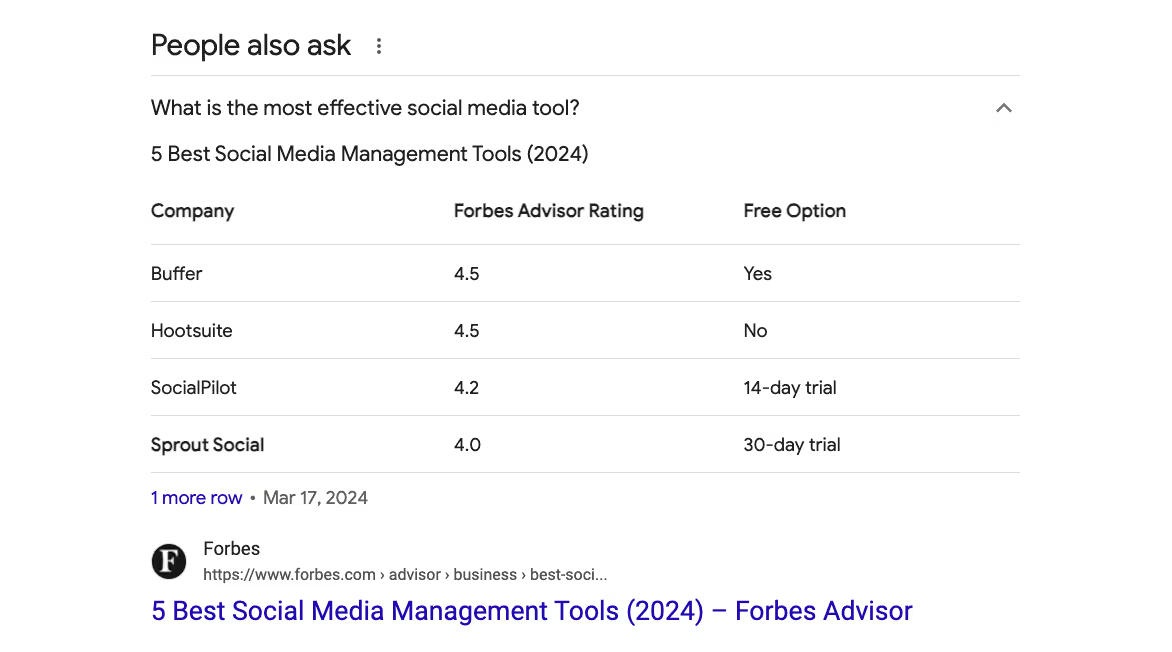
In this PAA box, Google is highlighting a bulleted list of the most popular social media platforms:

In the first example, given that the searcher is likely looking to compare social media tools, a table makes a lot of sense. In the second example, an answer in list form is helpful.
Don’t be surprised if you see the same PAA boxes appear across multiple related searches. And don’t be surprised if you see Google return the same result within the PAA box across multiple similar searches.
PAA placements may reduce the amount of traffic Google sends to some sites — for instance, if the PAA text fully answers the searcher’s question. But being included in a PAA box is usually better than not being included and will usually lead to more searchers visiting your website.
Moreover, after a searcher clicks on their first PAA question, Google tends to increase the number of PAA results shown — and the expanded PAA box pushes the rest of the search results further down the page, making it less likely that those publishers will receive traffic.

All this being said, there are questions about whether searchers frequently engage with PAA boxes. In an analysis of Google user behavior, Brian Dean from Backlinko found that only 3% of users interacted with a PAA box. However, this does depend on the search’s category and type, as the study went on to find that for keywords in the back pain supplements space, for example, the engagement rate was significantly higher: 13.6% — while for searches in the credit card space, the engagement rate was less than 2%.
This analysis seems to indicate that PAA boxes are unlikely to be a significant source of traffic for publishers. However, this study was fairly limited and involved only a small sample of 259 users after removing individuals who didn’t correctly follow the instructions.
In short, my take is that getting included in PAA boxes is a good thing most of the time. So if we can’t beat them, let’s join them.
Tips for Getting Your Pages into PAA Results
As with many things in SEO, nothing can guarantee that a page will be included in PAA boxes. But you can take a few steps to increase your chances.
Focus on the Right Pages
Most keywords are questions. But some keywords are clearly questions. According to the Semrush analysis mentioned earlier, search queries starting with words that indicate a direction question, like “why” and “where,” are more likely to return a PAA result on the SERP. In fact, search queries with clear question identifiers trigger PAA results 86% of the time.
On your site’s pages that target keywords that are questions, you’ll want to pay more attention to optimizing for PAA inclusion.
However, for pages on your website where the search intent is very specific and action-oriented, such as transactional pages, optimizing for a PAA result might not be worth the necessary time and effort.
Determine What PAA Results Exist Today
Google constantly runs experiments to determine which PAA questions are popular and helpful for searchers. Seeing the same PAA question appear on multiple SERPs is probably a good indication that Google considers that question helpful.
When you’re optimizing for PAA inclusion, a good starting point is to clearly address your target keyword’s PAA questions directly within your piece of content. There are a number of tools that can be used to identify PAA questions (so you don’t have to search manually), and I’ll highlight those toward the end of this article.
Match Your Formatting
It’s also important to align the formatting of your answers with the formatting that Google is currently showcasing.
For example, if a PAA box is displaying content from a table to answer a question, you’d want to create a table. And if a PAA box is displaying a bulleted list to answer a question, you’d want to create a bulleted list.
As with many things in SEO, you’ll want to go with the flow and align the formatting of your page to what’s already performing best on SERPs. At a minimum, using Google’s preferred format — with tables, bulleted lists, videos, and so on — will likely make your page more helpful for searchers, given that Google is actively testing what searchers prefer, and we can assume that they’ve got a much better view than we do.
Implement Schema Markup
While some SEOs debate the importance of using a schema, and Google’s team has said that structured data won’t impact search rankings directly, a schema does help search engines better understand the contents of a webpage.

Google’s John Mueller comments that structured data is likely not a direct ranking factor but an indirect one (Source: Twitter).
There are many types of schemas, including Q&A (QAPage) structured data. Google notes that properly marked-up pages are eligible for rich results displayed on SERPs.
However, whether Q&A structured data will impact the results displayed within PAA boxes is unclear. At a minimum, this schema will help Google make more informed decisions about your page.
Tools for PAA Optimization
As you likely know, there are many tools available to content marketers and SEOs. Platforms like Ahrefs and Semrush have several features for scraping and analyzing SERP elements, including PAA sections. However, a few tools were built for this specific purpose and are worth highlighting.
Positional
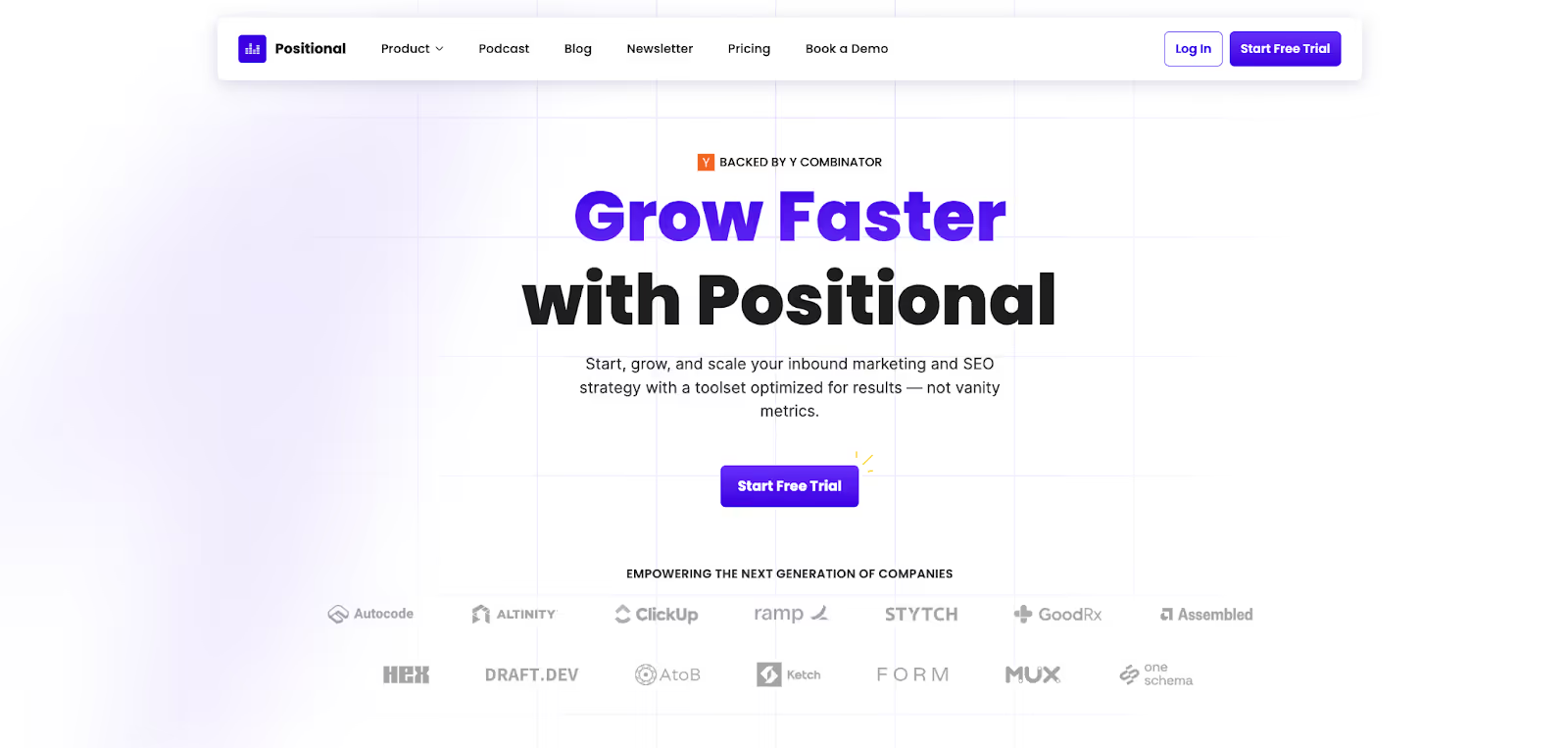
Positional offers a number of tools for content marketing and SEO — including its Keyword Research toolset, which features PAA questions directly in the Questions tab:
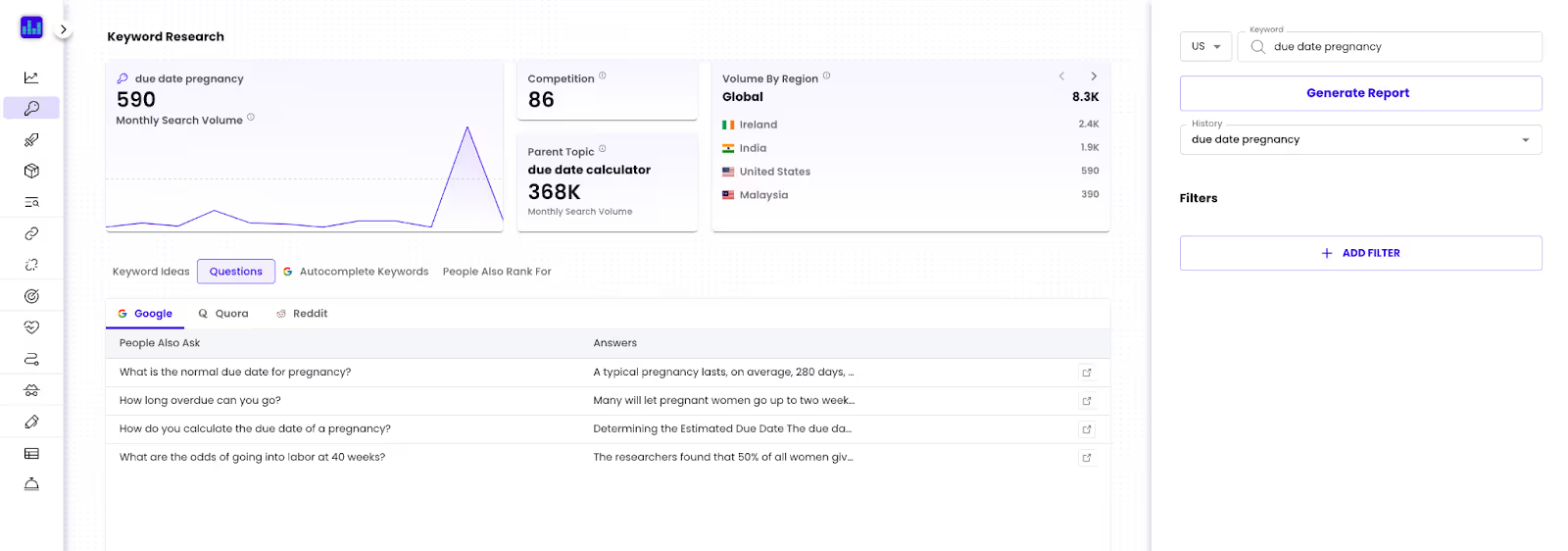
Positional also provides top questions from Quora and Reddit.
In addition, Positional’s Optimize toolset provides unanswered questions to address within your pieces of content:

While these unanswered questions aren’t necessarily PAA questions, they are questions that the top search results answer or address. When these tools are used in combination, you can enrich your content with answers to PAA questions, as well as to the questions that searchers are likely to have, or at least to the questions that Google likely perceives to be important.
Pricing: Starts at $299 per month.
AlsoAsked
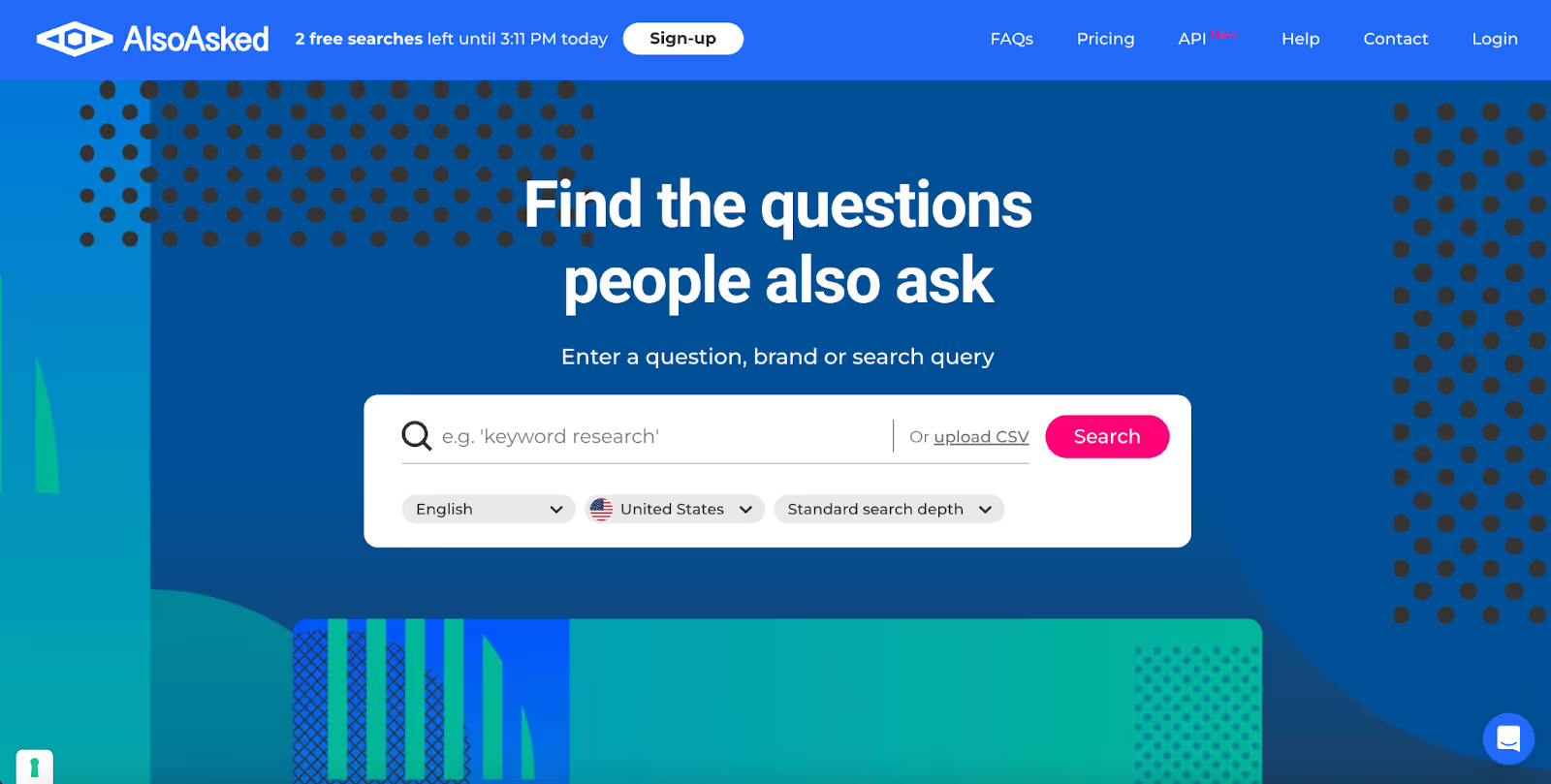
AlsoAsked is a popular tool for finding PAA questions. While narrow in focus, this dedicated tool allows you to quickly explore the questions people also ask and find long-tail keywords.
Start by entering a seed term; from there, AlsoAsked presents a visualization that groups and shows the relationships between PAA questions:
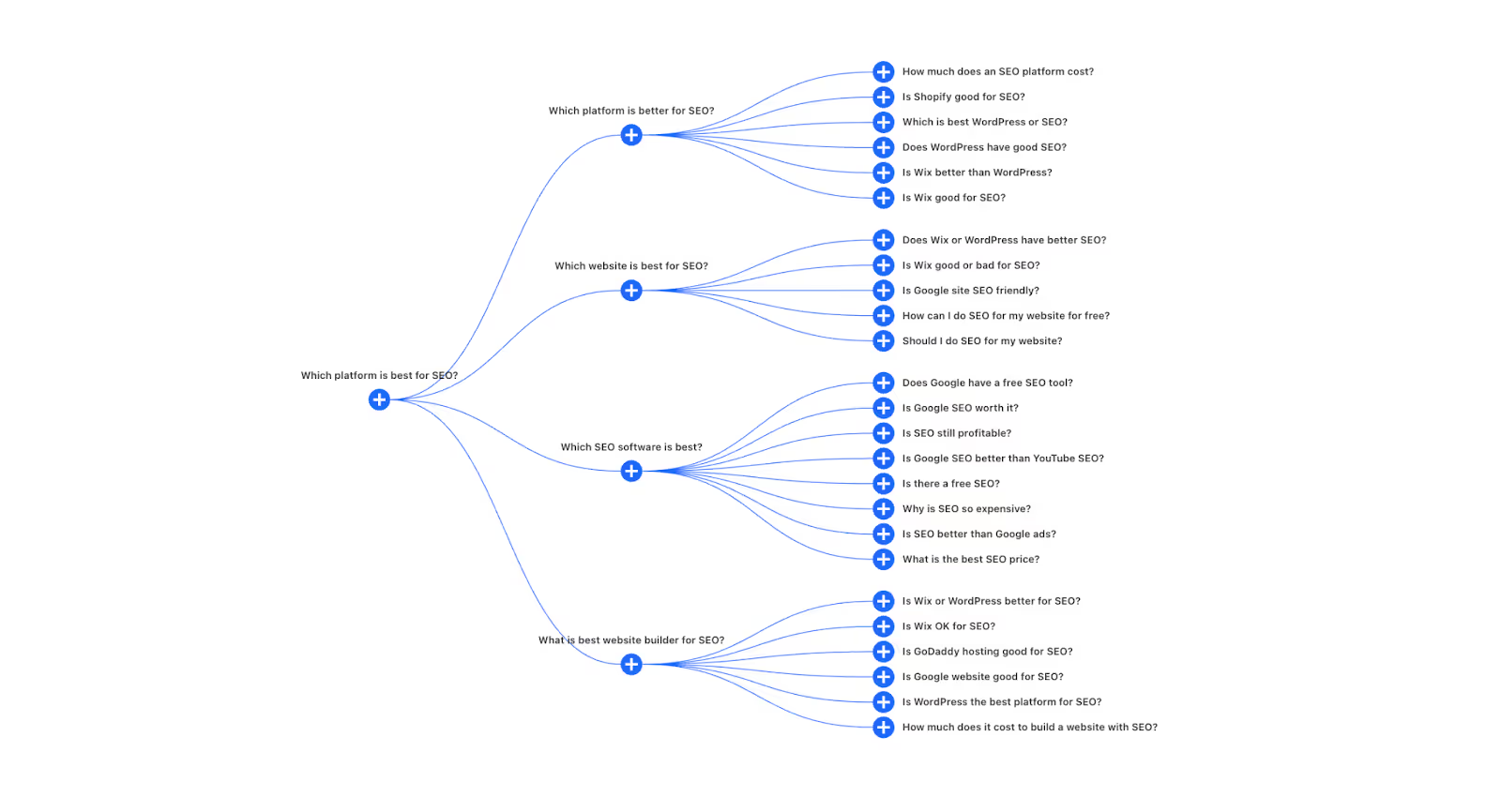
The tool supports a large number of filters, including country and by region filters.
In addition, the tool allows users to access the data in a number of different ways, including CSV export and API.
Pricing: Starts at $12 per month.
KeywordsPeopleUse

KeywordsPeopleUse offers a number of tools for determining what keywords people are going to use when searching in Google. It includes a feature set dedicated to PAA questions and exploration.
Similar to AlsoAsked, KeywordsPeopleUse provides search functionality and then visualization to find PAA keywords:
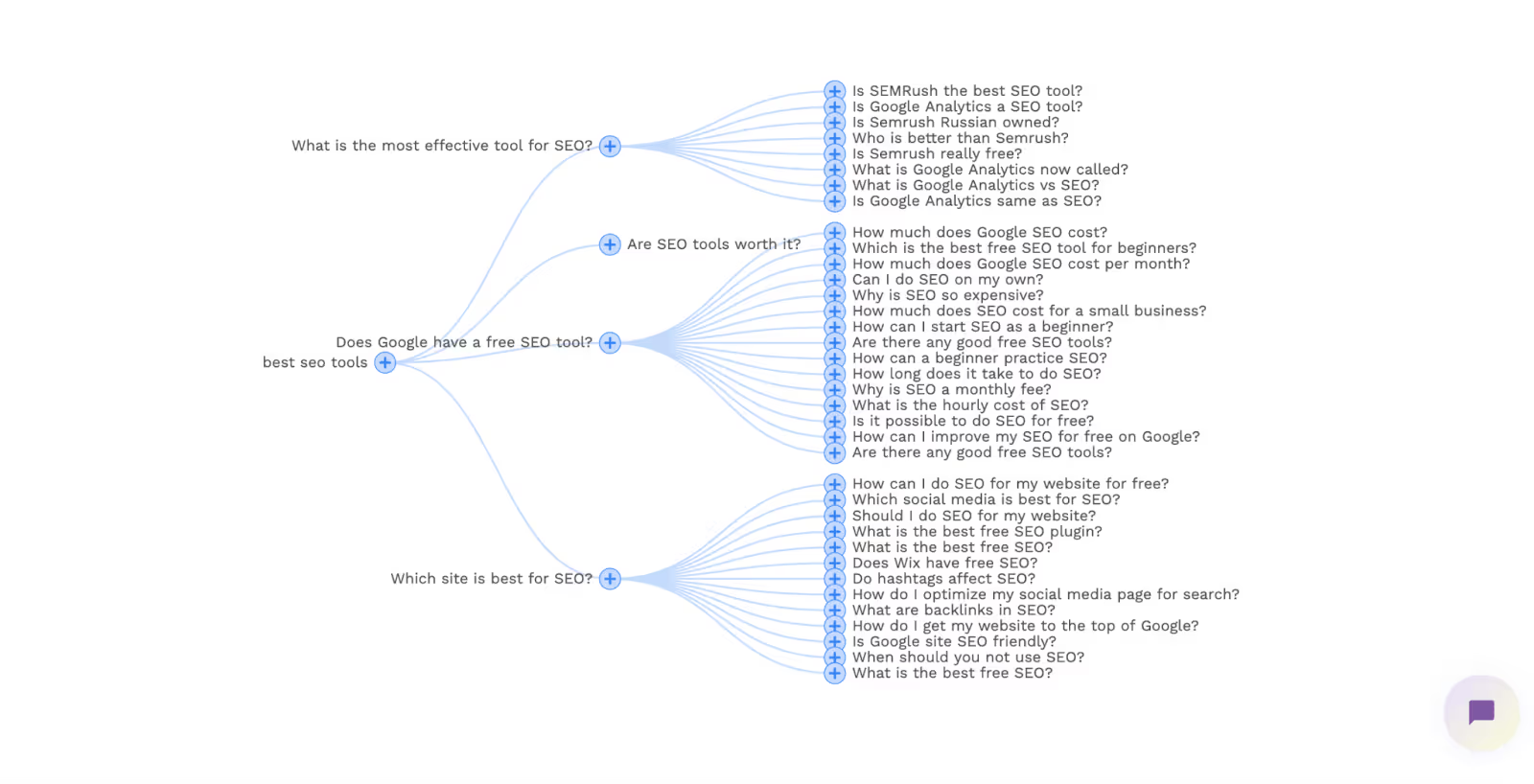
The platform allows for searches in specific languages and across specific regions.
Pricing: Starts at $0 per month.
Final Thoughts
People Also Ask is an important SERP feature, and you and searchers have likely been seeing it a lot more lately.
While the jury is still out on how often searches engage with PAA boxes, optimizing for PAA placement will, ultimately, likely push website publishers to improve the quality and depth of their webpages.
When trying to optimize for PAA inclusion, you’ll want to put the answers to these questions in the right format within your webpages. You’ll also want to pick the right pages to focus on, starting with pages that clearly hit keywords where questions, or words suggesting questions, are included.
Schemas and structured data might be helpful. At a minimum, adding Q&A structured data to your pages will help Google better understand the questions your pages address.
You don’t necessarily need a new tool to find or optimize for PAA boxes, but there are a few tools built specifically for this purpose, including Positional, AlsoAsked, and KeywordsPeopleUse.





